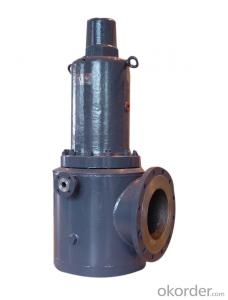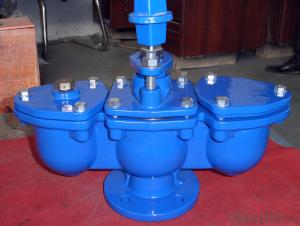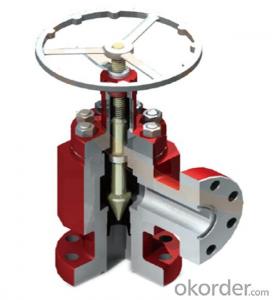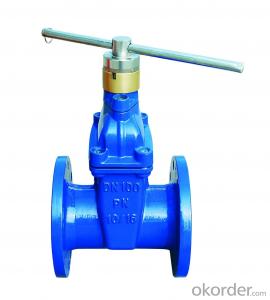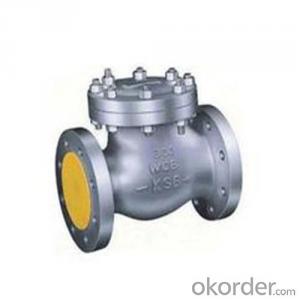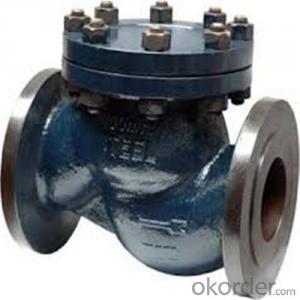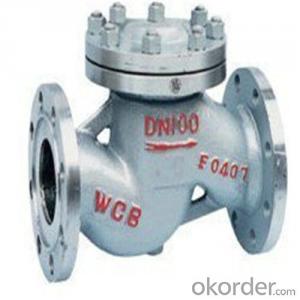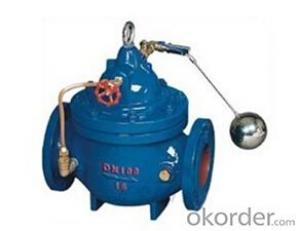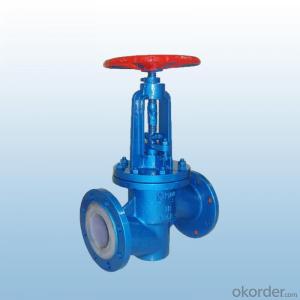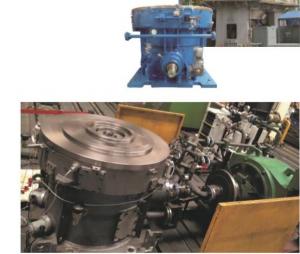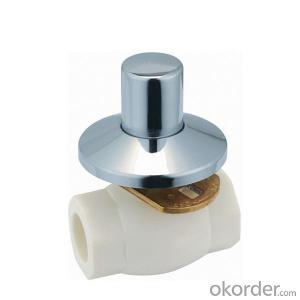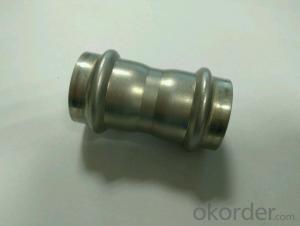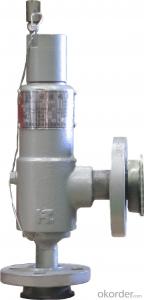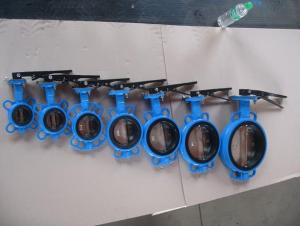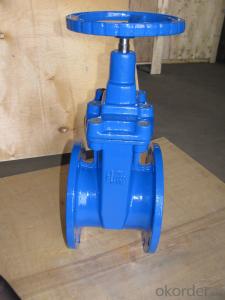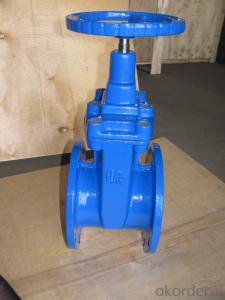High Performance WC6 Pressure Safety Valve
- Loading Port:
- China Main Port
- Payment Terms:
- TT OR LC
- Min Order Qty:
- -
- Supply Capability:
- -
OKorder Service Pledge
OKorder Financial Service
You Might Also Like
Application:
A pressure relief valve (PRV) is a safety device that relieves overpressure in a vessel or system. When the pressure of vessel or system increased beyond the specified design pressure or maximum allowable working pressure, PRV will be opened automaticly to relief the overpressure for proteding the vessel or system. The PRV will be closed if the pressure reached specified design pressure so that to ensure the normal operation and protect the vessel or system.
Our Pressure Relief Valve has been designed and manuractured according to following Standard:
♦ ISO 4123-1 Safety Devices for Portection Against Excessve Pressure
♦ API STD 526 Flanged Steel Pressure Relief Valves
♦ API STD 527 Seat Tightness of Pressure Relief Valves
♦ ASME Boiler and Pressure Vessel Code Section VIII Division 1, Rules for Construction of Pressure Vessels
Peformance:
♦ Type: Conventional, Bellows
♦ Size:1" D 2"- 8" T 10"
♦ Class:150lb~2500lb
♦ Temperature:-268~+538°C
♦ Fluid: Gas, Steam, and Liquid
♦ Material: Carbon steel, Stainless steel, Alloy steel
♦ The allowable tolerance of the set pressure: ≤±3%
♦ Overpressure: ≤10%(gas)/≤20%(liquid)
♦ Blowdown: ≤10%(gas)/≤20%(liquid)
♦ Tightness: conforms to API STD 527
Features:
♦The solid nozzle is screwed into the body, which makes the maintenance easy.
♦ The shape of the disc holder has been designed to enhance the effect of the fluid thrust for an instant lift of the disc.
♦ Blowdown control is provided with adjustable nuzzle ring only.
♦ The adequate terials and clearance between disc holder and guide , spindle and adjusting screw assures disc to lift successfully.
♦ The surface of both the disc and the nozzle seat are deposited with Stellite. Excellent flatness and surface finish of the seating surfaces by precision machining and lapping assure pressure relief valve to have high degree of seat tightness and long using life.
♦ The bellows of balanced bellows pressure relief valves can not only avoid and effect of variable back pressure in the system , but also protect spring and other trim components from corrosive media.
♦ Materials are chosen carefully , and the manufacture of the spring and the bellows has strict technological process. Each of them is tested and checked strictly.
- Q:It has been known that although tissue valves have lower rates of thrombotic episodescompared with mechanical valves, they are difficult to procure, and their longevity has not yet been proven. Is this true as of 2007? Thanks for answering.
- It is not true that tissue valves are difficult to procure--they are widely available from several manufacturers worldwide. Traditional wisdom has long held that tissue valves are for the elderly, but with the use of third generation tissue valves, which are treated to prevent calcification, in the hands of a top surgeon in a high-volume center, the choice is not so cut-and-dried anymore. Many top surgeons believe the newer tissue (porcine or bovine pericardial) valves will last twenty-five years or more (although, admittedly, they have not been studied long enough to prove this). Many top surgeons recommend the tissue valves in all but the mitral position for their patients in their 40's or even younger, believing that the risks of life-long anticoagulation therapy (which is required if one has a mechanical valve) can be greater than the risks involved in a second open heart surgery for valve replacement for some patients. What it comes down to is that valve choice is a highly individual matter--what may be the right choice for one patient of any given age may not be the right choice for another person of the same age. The following links are invaluable for making this very important decision. Do remember, whatever valve is chosen, the surgery will prolong life for the needy recipient. Whatever the choice, the patient should make it and never look back!
- Q:So I know the main purpose of the EGR valve is to recirculate some exhaust to the cylinders to reduce NOx emissions. However, a mechanic told me that a malfunctioning EGR valve can make the engine run way hotter, and that this can damage the pistons, or other components of the engine, over time. Is that true?
- Yes, very true. It would help if you stated what vehicle it was for. But let's say it's a Ford F-series truck with the 6.0L diesel, highly known for this problem. You can actually purchase an EGR delete which actually bypasses the valve so it won't burn the piston rings (the actual part that burns up). Buying this item only costs a few hundred and will save you thousands in the long run.
- Q:okay, well, I understand partials. But, on a trumpet, what does each valve do? I mean, I had this idea that each one was a half-step up from the previous...but that's not true. Is there some sort of pattern to them? Does each one have a different purpose?...Please answer as basically as possible. I don't play music very often, and I definitely don't speak brass-ish.
- 2nd okorder
- Q:Need some info. Ok, four valves per cylinder is better than two valves per cylinder. Fine, why did Ford REVERT to only 3 valves (my guess is to save cost SOHC)? Audi and VW are using five valves per cylinder on some cars, does this offer any advantage over a four valve engine? Maserati even experimented with a six valve per cylinder!!!! (see link) http://www.maserati-alfieri .uk/alfieri26.htm but abandoned it (my guess is cost again?) Why are we stuck at four valves or would more valves actually render more horsepower? Pop some ideas best answer to reasonable answer...
- The ideal situation would be to remove the head during the intake stroke and put it back on during the compression stroke, but, obviously, this isn't possible. On a naturally aspirated engine, the intake is the most critical because the air is moved only by a relatively small difference in pressures. The exhaust stroke, on the other hand, is aided greatly by the super heated temperature and rapid expansion of the gasses.
- Q:Hi. I looked at instructional videos for installing shutoff valves and instead of simply unscrewing old valve, the plumber simply cut the copper pipe. Is this necessary? Why can't I simply unscrew old shutoff valves from copper pipe?
- There are two types, screw on and solder on units. Plus if the pipes are very old or the threads worn on the pipe, it is best to start with a clean install instead of chasing leaking fittings for a week. If the old fitting looks very clean and it unscrews, simply buy a threaded valve unit.
- Q:The water shut off valve that is under my sink in the bathroom is leaking and I need to replace it. I am wondering if I need soder the new one or can I just put some thread tape around it.
- You could shut off either one. Find the valve on the water heater inlet and shut it off or find the water meter to your house, usually near the street and turn off the valve. You can probably use the same wrench that you intend to use to replace the leaking angle stop under your sink.
- Q:I have several stations in my automatic lawn sprinkler system. Each station has a valve that contains: 1. Manual Shutoff, 2. Flow Control Knob, 3. Solonid, 4. Anti-Siphon valve. Any way my question is this, Why does water continue to flow even when the manual shutoff is turned off and the flow control is also turned off?
- the guy above me got to it before i did. sounds like either a diaprham has just gone out, or the solenoid plunger is stuck, or there is a rock or something inside the valve, not closing it all the way. like trying to close a door with your foot in it. it will not close all the way. A word of advice would be to go ahead and replace the anti-siphon valves with regular inline valves. anti-siphon valves are pretty much junk any type. As far as diagnosing the problem now, 1. check your timer's programming and make sure that its not sending out power to this zone all of the time. ( this would make the timer bad). 2. carefully open the valve up ( with the water turned off of course), and inspect the diaprham. if it has any tears or ripps in it, get a new diaphram, if not, then flush the lines out with the valve open to see if any debris is in the line( rocks pipe pieces, etc.) and clean it out. 3. take out the solenoid and make sure the plunger in it is not sticking. ( if so replace the solenoid). 4. if all else fails just simply cut out and replace the entire valve and plumb in a new one properly. personally i would use either Hunter PGV valves, Rainbird DVF 100 valves, or Irritrol 205 series valves. all are inline models. antisiphon valves tend to fail. i work on sprinkler systems full time for 95 $ per hour of labor for our company. hope this can help you out John A
- Q:difference between swing type check valve and non return valve? i need best answer... if swing valve will be opened when the fuel s reverse motion???
- Non-return valve is another name for check valve. A swing check valve is just one type of check valve that uses a hinged gate to allow flow in only one direction. It operates sort of like a one-way fence gate, that you can open by pushing from one side, but you cannot open by pushing on the other side. Other types of check valves: Diaphragm, Ball, Lift, Duckbill. (:-o)
- Q:So i finaly got my check valve and my airstone. The airstone is actually a flat round airstone and is 5 inches in diameter to be in my 10gallon. Is it to big? though i have a tetra whisper air pump for 10-30g.And how do i place the check valve? Do i put it closer to the tank or closer to the pump? (just to make sure since i heard so many different ways people put it). Or does it even matter?And lastly, do i put the OUT side of the check valve facing towards the tank or the pump?Thanks! after this im ready to install it!
- Adequate the purpose you let a tank cycle in the first place is due to the fact of Bactria needs to grow that will maintain your water clear. As for overstocked. I consider your proper on the threshold of being over stocked. Just preserve the tank walking a lil longer and spot if it clears up. But when your 15 gallon tank has the filter from the ten gallon tank that could be why to you dont have sufficient water moving around to scrub it
- Q:i disconnected the heater valve because it went bad, but when i removed it i forgot how it came off when i went to the auto parts store. i just need to know what way it should be facing and which hose goes where? can someone please help me?
- You okorder for info. They have a great repair section that's free after you sign up. Manuals have lots of photos which should take care of your question.
1. Manufacturer Overview |
|
|---|---|
| Location | |
| Year Established | |
| Annual Output Value | |
| Main Markets | |
| Company Certifications | |
2. Manufacturer Certificates |
|
|---|---|
| a) Certification Name | |
| Range | |
| Reference | |
| Validity Period | |
3. Manufacturer Capability |
|
|---|---|
| a)Trade Capacity | |
| Nearest Port | |
| Export Percentage | |
| No.of Employees in Trade Department | |
| Language Spoken: | |
| b)Factory Information | |
| Factory Size: | |
| No. of Production Lines | |
| Contract Manufacturing | |
| Product Price Range | |
Send your message to us
High Performance WC6 Pressure Safety Valve
- Loading Port:
- China Main Port
- Payment Terms:
- TT OR LC
- Min Order Qty:
- -
- Supply Capability:
- -
OKorder Service Pledge
OKorder Financial Service
Similar products
New products
Hot products
Related keywords
